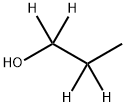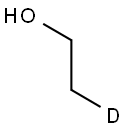TETRAHYDROFURAN-D8
Synonym(s):Deuterated tetrahydrofuran;Octadeuterotetrahydrofuran;THF deuterated;THF-d8
- CAS NO.:1693-74-9
- Empirical Formula: C4D8O
- Molecular Weight: 80.16
- MDL number: MFCD00044238
- EINECS: 216-898-4
- SAFETY DATA SHEET (SDS)
- Update Date: 2024-12-18 14:15:32

What is TETRAHYDROFURAN-D8?
Chemical properties
colourless liquid with an ether-like odour
The Uses of TETRAHYDROFURAN-D8
Tetrahydrofuran-d_8 is a deuterated THF that is used in various synthesis reactions and also used as a precursor for various polymers.
What are the applications of Application
Tetrahydrofuran-d8 is a deuterated THF that is used in various synthesis reactions and also used as a precursor for various polymers
Definition
ChEBI: Oxolane-d8 is a deuterated compound, a cyclic ether, a member of oxolanes, a saturated organic heteromonocyclic parent and a volatile organic compound.
General Description
Tetrahydrofuran-d8 may be used as a solvent in the synthesis of deuteriotris[bis(trimethylsilyl)amido]thorium and deuteriotris[bis(trimethylsiiyl)amido]uranium.
Properties of TETRAHYDROFURAN-D8
| Melting point: | −106 °C(lit.) |
| Boiling point: | 65-66 °C(lit.) |
| Density | 0.985 g/mL at 25 °C(lit.) |
| refractive index | n |
| Flash point: | 1 °F |
| storage temp. | 2-8°C |
| solubility | Chloroform (Slightly), Methanol (Slightly) |
| form | Liquid |
| color | Colorless |
| Specific Gravity | 0.99 |
| Water Solubility | Soluble in water. |
| BRN | 111854 |
| Stability: | Stable. Incompatible with strong oxidizing agents, strong reducing agents, strong bases, oxygen. May generate peroxides in storage if in contact with air. Highly flammable. Store under nitrogen. Hazardous polymerisation may occur. |
| CAS DataBase Reference | 1693-74-9(CAS DataBase Reference) |
| EPA Substance Registry System | Furan-2,3,4,5-d4, tetrahydro-d4- (1693-74-9) |
Safety information for TETRAHYDROFURAN-D8
| Signal word | Danger |
| Pictogram(s) |
 Flame Flammables GHS02  Exclamation Mark Irritant GHS07  Health Hazard GHS08 |
| GHS Hazard Statements |
H225:Flammable liquids H319:Serious eye damage/eye irritation H335:Specific target organ toxicity, single exposure;Respiratory tract irritation H351:Carcinogenicity |
| Precautionary Statement Codes |
P201:Obtain special instructions before use. P210:Keep away from heat/sparks/open flames/hot surfaces. — No smoking. P305+P351+P338:IF IN EYES: Rinse cautiously with water for several minutes. Remove contact lenses, if present and easy to do. Continuerinsing. P308+P313:IF exposed or concerned: Get medical advice/attention. |
Computed Descriptors for TETRAHYDROFURAN-D8
New Products
4-Fluorophenylacetic acid 4-Methylphenylacetic acid N-Boc-D-alaninol N-BOC-D/L-ALANINOL Tert-butyl bis(2-chloroethyl)carbamate 3-Morpholino-1-(4-nitrophenyl)-5,6-dihydropyridin- 2(1H)-one Furan-2,5-Dicarboxylic Acid Tropic acid S-2-CHLORO PROPIONIC ACID ETHYL ISOCYANOACETATE 2-Bromo-1,3-Bis(Dimethylamino)Trimethinium Hexafluorophosphate (6-METHYL-[1,3]DITHIOLO[4,5-b]QUINOXALIN-2-ONE INDAZOLE-3-CARBOXYLIC ACID 4-IODO BENZOIC ACID (2-Hydroxyphenyl)acetonitrile 4-Bromopyrazole 5,6-Dimethoxyindanone 2-(Cyanocyclohexyl)acetic acid 4-methoxy-3,5-dinitropyridine 2-aminopropyl benzoate hydrochloride 1-(4-(aminomethyl)benzyl)urea hydrochloride diethyl 2-(2-((tertbutoxycarbonyl)amino) ethyl)malonate tert-butyl 4- (ureidomethyl)benzylcarbamate Ethyl-2-chloro((4-methoxyphenyl)hydrazono)acetateRelated products of tetrahydrofuran








You may like
-
 Tetrahydrofuran-d8 99.5atom%D CAS 1693-74-9View Details
Tetrahydrofuran-d8 99.5atom%D CAS 1693-74-9View Details
1693-74-9 -
 Tetrahydrofuran-d8 CAS 1693-74-9View Details
Tetrahydrofuran-d8 CAS 1693-74-9View Details
1693-74-9 -
 TETRAHYDROFURAN D8 in glass ampoules 99.80% CAS 1693-74-9View Details
TETRAHYDROFURAN D8 in glass ampoules 99.80% CAS 1693-74-9View Details
1693-74-9 -
 1975-50-4 98%View Details
1975-50-4 98%View Details
1975-50-4 -
 2-HYDROXY BENZYL ALCOHOL 98%View Details
2-HYDROXY BENZYL ALCOHOL 98%View Details
90-01-7 -
 2-Chloro-1,3-Bis(Dimethylamino)Trimethinium Hexafluorophosphate 221615-75-4 98%View Details
2-Chloro-1,3-Bis(Dimethylamino)Trimethinium Hexafluorophosphate 221615-75-4 98%View Details
221615-75-4 -
 14714-50-2 (2-Hydroxyphenyl)acetonitrile 98+View Details
14714-50-2 (2-Hydroxyphenyl)acetonitrile 98+View Details
14714-50-2 -
 118753-70-1 98+View Details
118753-70-1 98+View Details
118753-70-1
Statement: All products displayed on this website are only used for non medical purposes such as industrial applications or scientific research, and cannot be used for clinical diagnosis or treatment of humans or animals. They are not medicinal or edible.